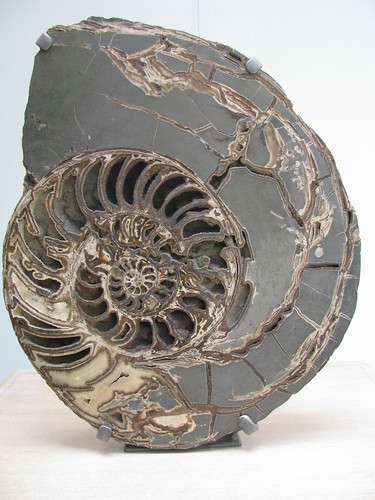tags: Natural History Museum, London, England, mystery object, travel
Mystery object at the Natural History Museum in London, England.
Image: GrrlScientist 3 September 2008 [larger view].
When racing through the Natural History Museum in London, I photographed this object and forgot to photograph the plaque that provided information about it. Besides showing this to you because it is beautiful and because I want to pique your interest in seeing the huge number of Natural History Museum images I will be posting soon, I would also be pleased if you could give me and my other readers more information about it.


Isn't this a fossilized Nautilus?
It looks like a fossilized chambered nautilus---but maybe is is some land snail?
Its a rolled up unicorn horn. It's obviously been deformed into that rolled up shape by the crushing weight of the waters of the great flood.
It's neither a unicorn's horn, nor a nautilus. It's a ram's horn . What do I win?
Early model flux capacitor.
Yeah, it's a nautilus shell, or possibly some kind of ammonite.
I am more inclined toward nautiloid rather than ammonite since the chamber walls where sutured to the outer shell seem pretty simple. Ammonoids evolved complex sutures during the Mesozoic probably because of attacks from marine reptiles whose jaws got pretty formidable as time passed. The strengthening from the complex sutures is akin to the increased strenth of corrugated cardbord.
I'd say it's 50/50 which, with context (what formatiion was it found in?) providing the definitive answer. biosparite is correct that early ammonites had simpler sutures than later ones (mostly) but some simply sutured ammonites persisted thru time. here is a good basic page on ammonites.
I'm pretty sure that's a Jurassic ammonite, probably from Dorset by the sediment. There are loads of them like that. If it is an ammonite, then it's a female (due to the size of the front chamber.
i wish i could provide some helpful clues, but i was unwise and snapped the image without writing down or photographing the plaque that accompanies the fossil. i do believe it is a fossil, even though there was a polished rock nearby that LOOKS like a fossil, but isn't. maybe one of the rockologists from the NHM will chime in?
I know it's a fossil. It's Bush's brain.
It is a fossilized ammonite. When I was in Patagonia I saw some in a museum there. They were huge, at least 2 -3 feet wide.
Looks like a sliced ammonite to me, too. Could very well be this one that the museum describes as one of its Paleontology Treasures:
"Parkinsonia . Ammonite cut in half showing septal walls, crystal "chambers" etc. Jurassic, Inferior Oolite."
See under Mollusca - Cephalopods on this page of the museum's website: http://tinyurl.com/6zkqqu
Way to go, Graeme!
indeed, this is a very large object and a geologist wrote to confirm what several of you have been saying; it is a fossilized ammonite.